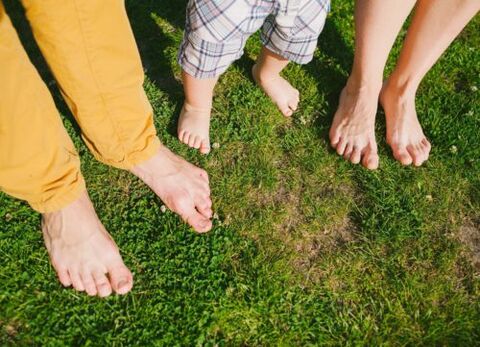The group of infectious diseases includes a leg fungus, which is a type of ringworm. This pathology is caused by microscopic fungi. Nail blade disease is called onychomycosis.

Fungal foot lesion
It is a very common condition in both men and women. The most common types of ringworm are:
- trichophytosis;
- candidiasis;
- epidermophytosis.
Some fungi can infect both animals and humans. It is necessary to know not only what ringworm is, but also why it develops. The main mechanism of human infection is contact. It is carried out directly and indirectly. In the first case, the fungi rise on the feet when they come into contact with the soil, plants or a sick person. Familial infections have been reported.
Indirect transmission of the pathogen is carried out after contact with animal care items and patients' personal belongings. These can be shoes, towels and scissors, as well as bath accessories.
Often the transmission factors are socks, socks and other personal items. Foot fungus can develop after visiting public baths and swimming pools. The process involves the skin of the legs and the nail plates.
The contributing factors are:
- increased sweating in the legs;
- the presence of calluses and abrasions; <2_img_rightxx>
- wear tight shoes;
- failure to observe personal hygiene;
- wear someone else's shoes;
- hostel accommodation;
- weakening of immunity;
- Poor nutrition;
- the presence of other skin diseases;
- hypovitaminosis;
- alcohol dependence;
- smoke;
- walk barefoot;
- endocrine disorders.
Debilitated people are more likely to experience this problem.
general clinical manifestations
The fungus on the soles and nails can go unnoticed for a long time. With this disease, the following symptoms are observed:
- peeling skin;
- dryness;
- the presence of diaper rash;
- thickening of the skin and nail plates;
- brittle nails;
- redness;
- itch;
- white or yellowish flower;
- the presence of erosion;
- pain in the skin.
The fungus on the feet looks different. It all depends on the type of pathogen and the underlying disease. Sometimes an unpleasant odor leaves a person. The fungus on the foot does not deteriorate the general condition. Intoxication symptoms are absent, as fungi are conditionally pathogenic microbes and are located in the superficial layers of the skin.

One leg is affected first. Then the fungi are introduced into the second limb. Most of the time, the following areas are involved in the process:
- back of foot;
- spaces between 4 and 5 fingers;
- Nail boards.
Depending on the clinical signs, the scaly, dyshidrotic and intertriginous forms of the disease can be distinguished. In the first case, scales appear on the reddened skin. Peeling is observed. Itching is an intermittent sign. It doesn't bother all patients. With a dyshidrotic form of ringworm, blisters appear in the fornix. They can increase in size. After a few days they open. Erosion appears in its place. An area of diaper rash appears. As erosion dries, scaling is observed.
If the fungus on the skin on the feet is aggravated by a bacterial infection, the exudate becomes purulent. Pain appears. Fever is possible. Fungal infection sometimes causes the development of intertriginous mycosis. Its main characteristic is the presence of cracks with white edges. The secretion develops over time. Pain appears. Erosion forms in the area of cracks. This form of the disease occurs chronically with summer exacerbations.
Development of onychomycosis of the legs
Along with foot fungus, onychomycosis can be found. With it, the nails are involved in the process. The prevalence of this pathology in the population is 10-20%. In recent years, the incidence of illnesses in children has increased. Fungi actively grow and multiply not only on the skin but also on the nail plates.
People with varicose veins, hyperhidrosis, flat feet, and endocrine disorders often face similar problems. Fungi multiply inside the nail, gradually leading to its destruction. If the disease is not cured, it can last for years. The end result is nail detachment. Hyperkeratosis often develops.

Distinguish between hypertrophic, normotrophic, and atrophic onychomycosis. In the first case, the nail dulls and thickens. With atrophy, the color of the plaque changes to brown. Your detachment is observed. In normotrophic onychomycosis, the shape and size of the nail do not change. With the development of onychomycosis in the feet, the following symptoms are observed:
- decreased nail density;
- changing its color;
- the presence of white or yellow spots;
- itch;
- cracked skin;
- peeling;
- thickening of the plaque;
- increased fragility.
If treatment for nail fungus is not carried out, there is a risk of developing paronychia. In this condition, there is purulent inflammation of the nail bed.
Examination and treatment tactics
You need to know not only how the fungus starts on the foot, but also how to get rid of it. The therapy regimen is determined by the attending physician. Before that, the following studies will be needed:
- inspection with wooden lamp;
- scraping microscopy;
- general clinical analyses;
- sowing in nutrient medium.

Differential diagnosis is made with psoriasis, onychodystrophy, lichen planus, congenital pachyonychia, trauma and eczema.
Every experienced dermatovenerologist knows how to treat nail fungus. Antifungals are used in the form of solutions, creams and varnishes.
Toe fungus treatment usually involves surgery. The affected nail is removed.
With a long course of epidermophytosis, a systemic remedy for foot fungus based on miconazole or ketoconazole may be prescribed. Proper treatment kills germs. There are products for sale that adapt to the passage of the affected nail plates. They come in the form of patches.
To increase the effectiveness of the treatment of skin fungus on the legs, vitamins, antibiotics (in the case of secondary infection) and various ointments based on zinc and salicylic acid are prescribed.
You also need to follow some rules:
At the end of therapy, a scaling control study is performed.
























